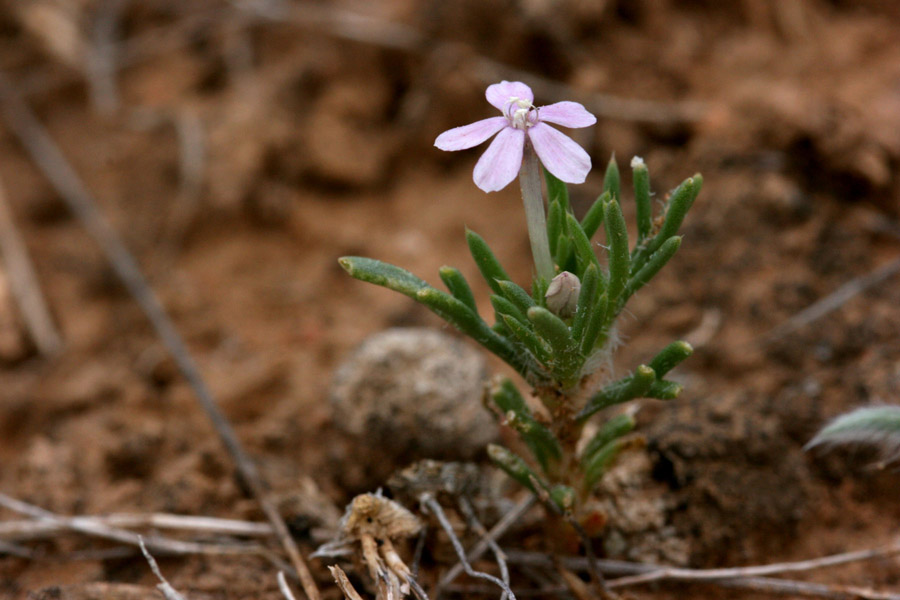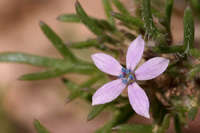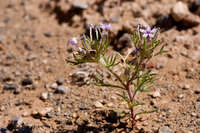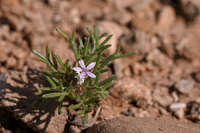|
|
|
|
Family: Polemoniaceae
dwarf ipomopsis
[Gilia pumila Nutt.] |
PLANT: Annual, 3-18 cm tall, simple to branched; stems short glandular to short woolly. LEAVES: subglabrous to short woolly, often glandular, lower deeply lobed, upper lobed to entire. INFLORESCENCE: a congested terminal head, bracteate, the bracts entire to toothed; flowers subsessile. FLOWER: calyx 3-6 mm long, the lobes lanceolate, acuminate; corolla lavender to purplish, the tube 4-8 mm long, the throat 0.5-1 mm wide, the lobes acute to rounded; stamens inserted on the throat between the lobes; filaments subequal; anthers and stigma slightly exserted. CAPSULE: 3-5.5 mm long; seeds 2-5 per locule. 2n=14. NOTES: Sandy soils, desert shrublands, pinyon-juniper woodland; Apache, Coconino cos.; 1490-1920 m (4900-6300 ft);Mar-Jun(Oct); UT to WY, s to TX, n Mex. REFERENCES: Dieter H. Wilken and J. Mark Porter, 2005, Vascular Plants of Arizona: Polemoniaceae. CANOTIA 1: 1-37. VPAP (Wilkens and Porter 2005), Allred and Ivey 2012 Duration: Annual Nativity: Native Lifeform: Forb/Herb General: Annual herbs, 3-18 cm tall; stems several from the base, unbranched to sparingly branched, short-glandular to short-woolly. Leaves: Basal leaves deeply lobed, usually withering before flowering; stem leaves alternate, lobed or entire; all leaves subglabrous to short-woolly, often glandular. Flowers: Showy and lavender, subsessile in congested terminal heads; calyx consisting of 5 glandular, acuminate-tipped sepals, 3-6 mm long, connected to each other by papery membranes; corolla rotate to salverform and 5-lobed, lavender to purplush, the tube 4-8 mm long and the throat 0.5 to 1 mm wide, and the lobes 2-4 mm long, rounded to acute-tipped; anthers and stigma slightly exserted beyond corolla throat. Fruits: Capsules 3-6 mm long, containing 2-5 seeds per locule. Ecology: Found in sandy soils, in desert shrublands and pinyon-juniper woodlands, from 4,500-6,500 ft (1372-1981 m); flowers March to June, occasionally as late as October. Distribution: WY, UT, CO, AZ, NM, and TX; south to n MEX Notes: Distinguished as a small taprooted annual with light lavender flowers in rounded clusters at branch tips; stems that are lightly woolly and usually glandular as well, at least on the upper parts of the stems; a cluster of pinnately-lobed basal leaves that is mostly withered by the time the plant flowers; and stem leaves that are not lobed or have fairly small lobes. Similar to I. polycladon, but that species has toothed bracts at the base of the inflorescence; short curly hairs on the stems; and smaller white flowers, with the corolla tube 3-5 mm long and lobes 1-2 mm long (I. pumila has bracts at the base of the inflorescence that are not toothed; woolly stems; and larger lavender flowers, the corolla tube 4-8 mm long and lobes 2-4 mm long). I gunnisonii is also similar but none of its leaves are lobed. I congesta has similar rounded clusters of flowers, but it is a perennial. Ethnobotany: Unknown, but other species in the genus have uses. Etymology: Ipomopsis means like Ipomoea, the morning glory genus; pumila means dwarf, referring to the plant's small stature. Editor: AHazelton 2017 |





